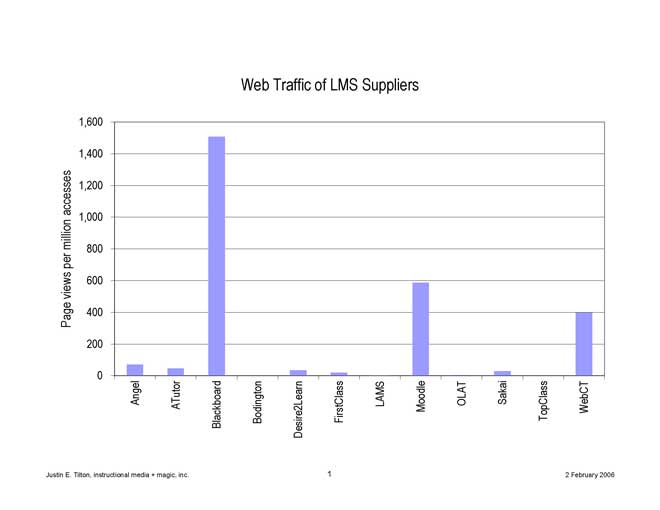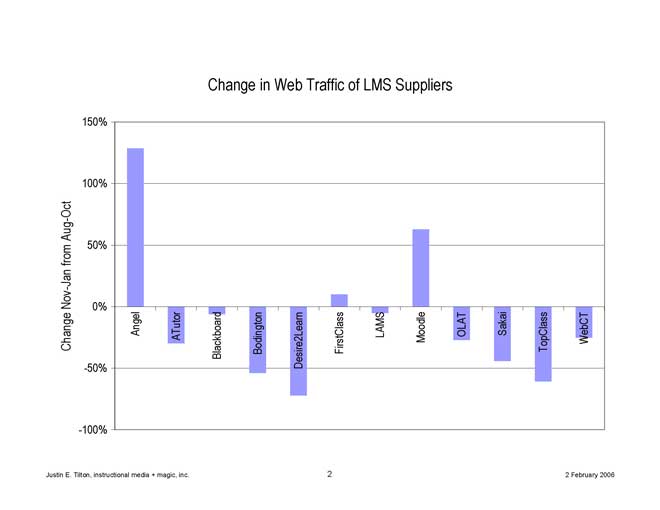Robert Garza raises the issues that all of the CMS suppliers
are carefully consideringwhat will be sustainable in the long-runand at what
price.
Some comments:
Blackboard did ask Sakai to become a commercial affiliate.
Sakais responsebased, in part on uPortals positive experience with Uniconwas to
focus on those commercial firms that would agree to support the Sakai product.
To promote interoperability Blackboard extended an invitation to both uPortal
and Sakai to attend the Building Blocks Conference and suggest how better to
work together in the future.
In an interview with Blackboards Matt Pittinskey in the May issue of Campus
Technology, he said interoperability of
Blackboard, Moodle, and Sakai (via Building Blocks, Moodle blocks, and tools)
is a Blackboard priority. Blackboard continues to implement standards that
support interoperability of learning materials, blocks and tools, and
integration with student, library, and other administrative systems.
Blackboards offer to work closely with all open source CMS
projects is welcomed and I believe genuine. As it turns out, the Blackboard
executives, Martin Dougiamas, and Jason Cole will all be attending the IMS
ALT-I-Lab meeting next month in Indianapolis. I hope they have the opportunity meet.
As the cited Blackboard presentation points out, long-term
support of any software product is important to users. The OSS Watch project at
the University of Oxford has hosted three conferences on open source; the last
focused on sustainability. You may want to review the presentations
(http://www.oss-watch.ac.uk/). OSS Watch expects to issue a report shortly on
sustainability of open source software.
Following the Savannah MoodleMoot in February, there was a
friendly debate at IYC's eLearning 2006 with Blackboard. Blackboards Afroze
Mohammed again stressed long-term support, a point well received by an audience
that delivers eLearning every day to thousands of students. Martins keynote at
the same conference was exceptionally well received. His focus on teaching resonated with this audience that must deliver effective courses. I hear
Martins presentation at the MoodleMoot and Jason Cole luncheon keynote
will be available soon on DVD.
A. T. Wyatt points out the importance of having an
entry-level product. Several of the software suppliersIBM, SugarCRM, and
MySQLhave open source entry-level software products and subscription support
services available as use grows. (Red Hat's success is solely based on subscripton support). Blackboard is aware of this emerging business
model; Blackboard Basic successfully fulfilled this role for a number of
years. Moodles market share appears to come from those initial implementations
that, over time, become enterprise level implementations. This observation of the
Moodle community was presented at the April OSS Watch Conference; on an average
each five participants in a Moodle activity results in one institutional
implementation.
Your comment about Moodle at the enterprise level was
first challenged by success in New Zealand and now by Open University in the
UK. Within a few months we will know more about the success of Open University.
It will be extending Moodle to an increasing number of its 150,000 students. If
OU UK is successful, and they are confident, then Moodle will be established as
an enterprise system.
The question about compliance with IMS standards was raised.
One of the objectives of Open University UK and Open University NL has been
full support in Moodle. OU UK will be assisting Moodle to become compliant.
(See http://www.immagic.com/eLibrary/GENERAL/IMM/I060413F.pdf
for details). OU NL was the original motivation for learning design. They
believe now there is sufficient experience that Learning Design will become
important to course designers. According to Jason Cole, Learning Design 2.0, all levels,will be
available in a later version of Moodle.
You also bring up the question of integration, specifically
with Banner. When integration is defined by the convenience of single signon,
the ESUP Portail project has integrated uPortal and Moodle using JA-SIGs
CAS. This makes moving from one application to another possible without signon,
and was well received by the 17 universities. SunGard Higher Education has been
discussing a broader integration of Banner and Blackboard with Georgetown
Universitys Interoperability Center. A student registering in Banner would
have course access established in Blackboard immediately. As this work progresses
I would expect SunGard to all be interested in Moodle integration as well.
Rather than focus on the differences between Course
Management Systems, I hope the focus will be on how to improve teaching and
learning; which system is secondary. Carol Twiggs work on course redesignimproved
completions and reduced costs of gateway coursesmay be key to accommodating
larger enrollments with current resources, improving the success of
less-prepared students, and increasing student satisfaction using the technology made
available by Blackboard, Bodington, Sakai, OLAT, Moodle, and others. I suggest you read her presentation to the U.S. National Commission on the Future of Higher Education (http://www.ncat.edu/).








 image) seems to be a little too coarse-grained.
image) seems to be a little too coarse-grained. .
.